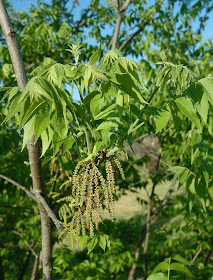 | |
| Faith female flower cluster 2018 |
Lets look at two cultivars to see the differences between protandrous and protogynous cultivars. I'll start will Kanza, a protogynous cultivar. The photo at left shows a cluster of Kanza female flowers. Note that the stigmatal surface of each flower is tinged black. This is the first indication that these flowers are already pollinated.
Kanza catkins, the male flowers, are still green (photo at right). Catkins will turn yellow in color just before each pollen sac opens up to release pollen into the air. These catkins will be opening up sometime this week.
Hark is a protandrous cultivar. In the photo at left, Hark catkins have turned fully brown indicating that pollen sacs have already opened and pollen has been released. Look closely at the catkins and you'll see that each pollen sac is split open and the catkin is almost ready to fall from the tree.
Hark pistillate flowers are not very showy, but as a wind pollinated crop, it doesn't need colorful flowers (photo at right). These Hark female flowers have not yet started to glisten with stigmatal fluid. When a female flowers becomes receptive to pollen the stigma produces a fluid to help capture pollen from the air.
It takes trees with both flowering habits to ensure a successful pollination season. A protandrous cultivar like Hark was shedding pollen when a protogynous cultivar like Kanza had receptive pistillate blooms. In a few days, Kanza will start to release pollen just in time to land on receptive Hark female flowers.
Pecan trees have developed this flowering dichogamy to ensure cross pollination and preserve hybrid vigor within the species.



